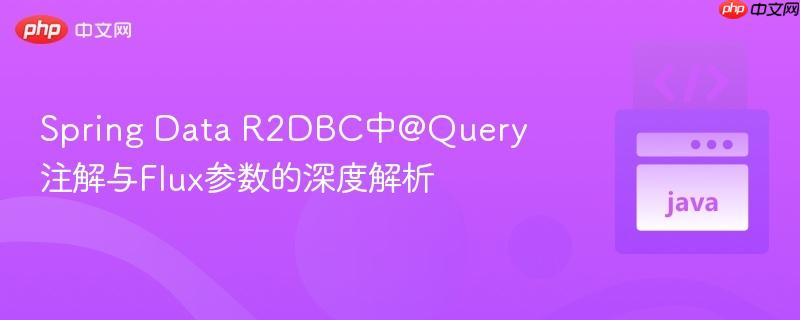
本文深入探讨了spring data r2dbc在使用`@query`注解时,将`flux`作为方法参数所遇到的`illegalargumentexception: value must not be null`错误。我们分析了该问题的根源在于`@query`注解不支持直接处理响应式流参数,并提供了解决方案:优先利用spring data的派生查询机制处理`flux`参数,以实现类似`findallbyid(publisher idstream)`的功能,避免不必要的`@query`使用。
Spring Data R2DBC为响应式关系型数据库操作提供了强大的抽象层。通过定义Repository接口并继承ReactiveCrudRepository等,开发者可以轻松实现基本的CRUD操作。对于更复杂的查询,Spring Data提供了多种机制,其中@Query注解允许开发者直接编写SQL语句,以实现高度定制化的数据访问逻辑。
然而,在处理响应式流(如Flux)作为查询参数时,@Query注解的行为可能与预期有所不同,尤其是在试图模拟内置的批量操作时。
当尝试在自定义Repository方法中使用@Query注解,并传入一个Flux类型的参数时,例如:
public interface PersonRepository extends ReactiveCrudRepository<Person, Person> {
@Query("SELECT id, name FROM Person WHERE id = ?")
Flux<Person> myMethod(Flux<Person> person); // 尝试使用Flux作为参数
}在实际执行时,这会导致一个IllegalArgumentException: Value must not be null的错误。完整的异常堆栈会指向org.springframework.util.Assert.notNull和org.springframework.r2dbc.core.Parameter.from,表明在参数绑定阶段,Spring Data R2DBC未能从Flux参数中解析出一个具体的、非空的绑定值。
问题分析:
这个问题的核心在于@Query注解的设计目的。它主要用于绑定单个、已解析的参数值到SQL语句中的占位符(如?或命名参数:param)。当@Query遇到一个Flux或Publisher类型的参数时,它并不会像内置的findAllById(Publisher idStream)方法那样,自动“订阅”这个流并为流中的每个元素执行一次查询,或者将其收集起来生成一个IN子句。相反,它试图将整个Flux对象本身作为一个单一值进行绑定,而Flux对象本身(作为流的描述符而非具体数据)对于SQL参数绑定来说是无效的,因此抛出Value must not be null异常。
换句话说,@Query注解在参数绑定层面,不具备对响应式流进行“解包”或“扁平化映射”(flatMap)的能力。
在Spring Data R2DBC中,对于需要以Flux或Publisher作为参数进行批量查询的场景,最佳实践是利用其强大的派生查询(Derived Queries)机制。如果方法名遵循特定的命名约定,Spring Data可以自动生成相应的查询,而无需@Query注解。
例如,如果你想实现一个根据一系列ID查询Person对象的功能,并且这些ID以Flux
public interface PersonRepository extends ReactiveCrudRepository<Person, Long> { // 注意ID类型应与实体ID类型匹配
// Spring Data会自动根据方法名生成查询,支持Flux/Publisher参数
Flux<Person> findAllByIdIn(Flux<Long> ids); // 或者直接使用 findAllById(Publisher<Long> ids)
// 也可以根据其他字段进行批量查询
Flux<Person> findAllByNameIn(Flux<String> names);
// 对于单个字段的精确匹配,也可以这样定义
Flux<Person> findAllByName(Flux<String> names);
}示例代码:
假设我们有以下Person实体:
import lombok.*;
import org.springframework.data.annotation.Id;
import org.springframework.data.relational.core.mapping.Column;
import org.springframework.data.relational.core.mapping.Table;
import reactor.core.publisher.Flux; // 引入Flux
@Getter
@Setter
@ToString
@Data
@NoArgsConstructor
@AllArgsConstructor
@Table(value = "Person", schema = "mySchema")
public class Person {
@Id
@Column("id")
Long id;
@Column("name")
String name;
}以及其对应的Repository接口:
import org.springframework.data.r2dbc.repository.ReactiveCrudRepository;
import reactor.core.publisher.Flux;
public interface PersonRepository extends ReactiveCrudRepository<Person, Long> {
// 正确的用法:利用派生查询,无需@Query注解
Flux<Person> findAllById(Flux<Long> idStream); // 效果等同于findAllByIdIn
// 如果需要更具体的名称,也可以使用In关键字
Flux<Person> findAllByIdIn(Flux<Long> idStream);
// 根据名称批量查询
Flux<Person> findAllByNameIn(Flux<String> names);
}在你的主应用中调用:
import org.slf4j.Logger;
import org.slf4j.LoggerFactory;
import org.springframework.boot.CommandLineRunner;
import org.springframework.boot.SpringApplication;
import org.springframework.boot.autoconfigure.SpringBootApplication;
import org.springframework.boot.context.properties.EnableConfigurationProperties;
import org.springframework.context.annotation.Bean;
import reactor.core.publisher.Flux;
import java.util.function.LongSupplier;
import java.util.stream.LongStream;
import org.apache.commons.lang3.RandomUtils; // 假设已引入此依赖
@SpringBootApplication
@EnableConfigurationProperties({ApplicationProperties.class}) // 替换为你的配置属性类
public class MyApplication {
private static final Logger logger = LoggerFactory.getLogger(MyApplication.class);
public static void main(String[] args) {
SpringApplication.run(MyApplication.class, args);
}
@Bean
public CommandLineRunner consume(PersonRepository personRepository) {
return args -> {
LongSupplier randomLong = () -> RandomUtils.nextLong(1L, 10L); // 假设ID范围为1-10
Flux<Long> personIds = Flux.fromStream(LongStream.generate(randomLong).boxed()).take(3);
logger.info("Generated Person IDs to query: " + personIds.collectList().block()); // 打印生成的ID
// 使用派生查询方法,传入Flux参数
personRepository.findAllById(personIds)
.doOnNext(person -> logger.info("Processed Person: " + person))
.doOnError(e -> logger.error("Error during processing: " + e.getMessage(), e))
.doOnComplete(() -> logger.info("All persons processed."))
.subscribe(); // 订阅以触发执行
// 确保应用程序不会立即退出,以便观察异步结果
Thread.sleep(2000); // 生产环境中不推荐,仅为示例演示
};
}
}注意事项:
在Spring Data R2DBC中,当Repository方法需要以Flux或Publisher作为输入参数时,应优先考虑使用Spring Data提供的派生查询机制,例如findAllById(Flux
以上就是Spring Data R2DBC中@Query注解与Flux参数的深度解析的详细内容,更多请关注php中文网其它相关文章!

每个人都需要一台速度更快、更稳定的 PC。随着时间的推移,垃圾文件、旧注册表数据和不必要的后台进程会占用资源并降低性能。幸运的是,许多工具可以让 Windows 保持平稳运行。

Copyright 2014-2025 https://www.php.cn/ All Rights Reserved | php.cn | 湘ICP备2023035733号